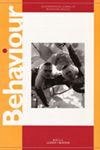Insight into manta ray behaviour using animal-borne Crittercams
IF 1
4区 生物学
Q4 BEHAVIORAL SCIENCES
引用次数: 0
Abstract
Abstract Animal-borne video cameras equipped with depth and temperature sensors were deployed on 16 reef manta rays ( Mobula alfredi ) in Raa Atoll, Maldives and 12 oceanic manta rays ( Mobula birostris ) in the Revillagigedo Archipelago, Mexico. These deployments provided descriptive behavioural data that give vital context to existing biotelemetry data and enabled a comparison of the social dynamics between the two manta ray species. Overall, cruising was the most dominant daytime behaviour recorded for both species. For M. alfredi , cleaning was the second most common behaviour, followed by courtship and feeding. No courtship behaviour was recorded for M. birostris . Across M. alfredi and M. birostris deployments, individuals spent an average of 43 and 8% of recorded time interacting with conspecifics, respectively. Sociability was higher in M. alfredi than M. birostris , however the findings should be interpreted with caution beyond the two deployment populations and times. Crittercams captured multiple courtship events of M. alfredi at depths greater than recreational scuba diving limits and captured previously undocumented interspecific interactions with M. mobular . Crittercam deployments also recorded M. alfredi travelling in groups and hugging the contours of the ocean floor, possibly as a tactic to reduce predation risk and/or improve swimming efficiency, enforcing the importance of this novel technology as a valuable tool to gain new insight into the ecological drivers of habitat use by these species. Lastly, these quantitative and descriptive results provide context for future hypothesis-driven research questions using animal-borne video cameras for mobulid rays.用动物携带的动物摄像机观察蝠鲼的行为
在马尔代夫Raa Atoll的16条礁蝠鲼(Mobula alfredi)和墨西哥Revillagigedo群岛的12条海洋蝠鲼(Mobula birostris)身上配置了配有深度和温度传感器的动物载摄像机。这些部署提供了描述性行为数据,为现有的生物遥测数据提供了重要的背景,并使两种蝠鲼之间的社会动态得以比较。总的来说,巡航是这两个物种白天最主要的行为。对alfredi来说,清洁是第二常见的行为,其次是求偶和觅食。没有记录到斑胸蚜的求偶行为。在M. alfredi和M. birostris部署中,个体平均花费43%和8%的记录时间分别与同种动物互动。M. alfredi的社交性高于M. birostris,然而,研究结果应该谨慎地解释,而不是两个部署种群和时间。生物摄像机在超过休闲潜水极限的深度捕捉到了M. alfredi的多次求偶事件,并捕捉到了以前未记载的与M. mobular的种间相互作用。Crittercam的部署还记录了M. alfredi成群结队地游动,并拥抱海底的轮廓,这可能是一种降低捕食风险和/或提高游泳效率的策略,强调了这项新技术的重要性,它是一种有价值的工具,可以获得这些物种使用栖息地的生态驱动因素的新见解。最后,这些定量和描述性的结果为未来的假设驱动的研究问题提供了背景,这些研究问题使用动物携带的摄像机拍摄活动射线。
本文章由计算机程序翻译,如有差异,请以英文原文为准。
求助全文
约1分钟内获得全文
求助全文
来源期刊

Behaviour
生物-动物学
CiteScore
1.80
自引率
7.70%
发文量
44
审稿时长
3 months
期刊介绍:
Behaviour is interested in all aspects of animal (including human) behaviour, from ecology and physiology to learning, cognition, and neuroscience. Evolutionary approaches, which concern themselves with the advantages of behaviour or capacities for the organism and its reproduction, receive much attention both at a theoretical level and as it relates to specific behavior.
 求助内容:
求助内容: 应助结果提醒方式:
应助结果提醒方式:


